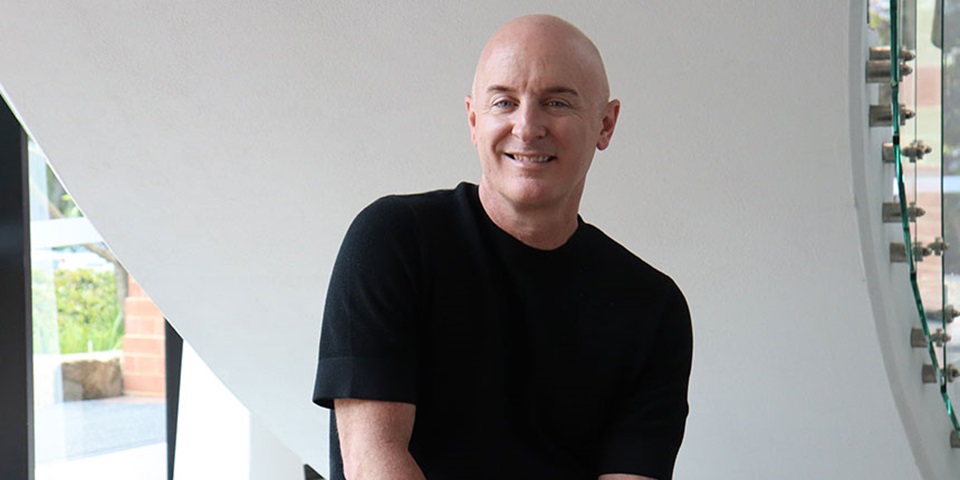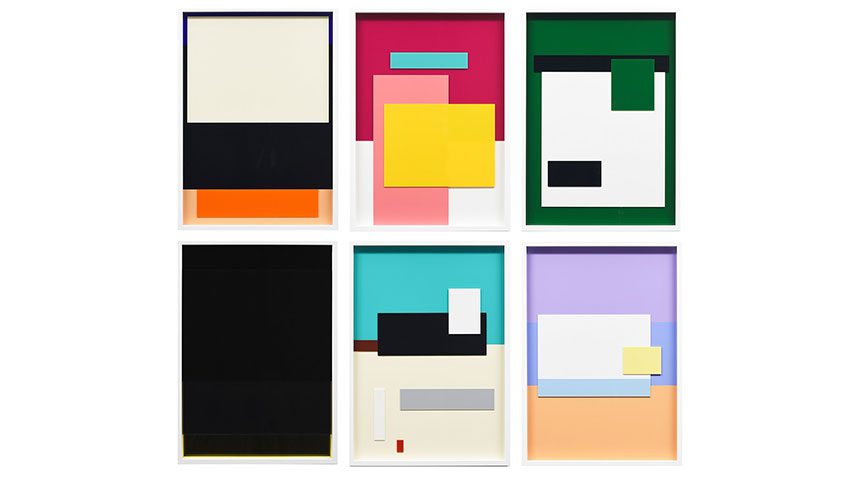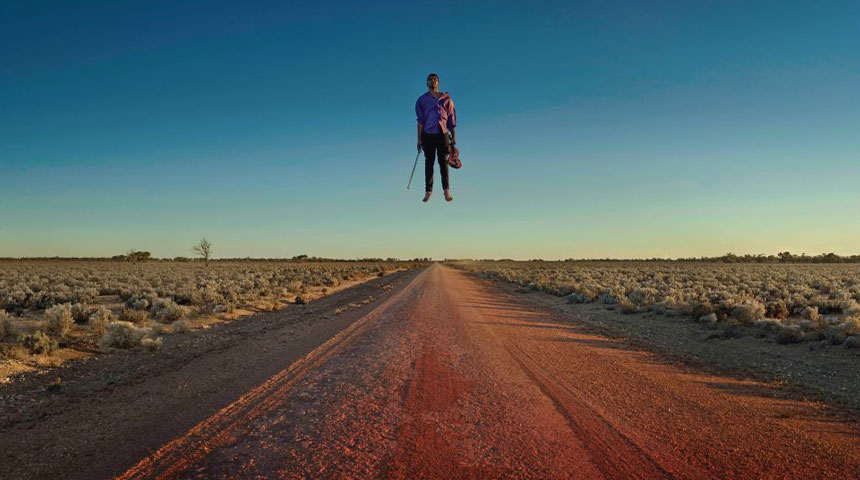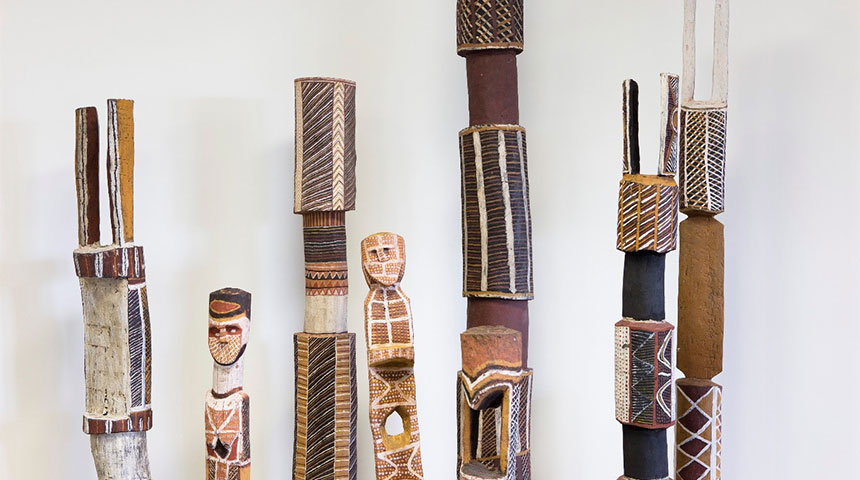Blog
A gentle steer of the collection

Since its foundation in 1974, Murdoch's growth has been mirrored by the expansion of its art.
Over the last sixteen years the Murdoch University Art Collection has been steadily developed by its curator, Mark Stewart. His vision has realised an increasingly diverse and respected body of work that reflects Murdoch’s reputation as a university that does things a little differently. We caught up with Mark to find out about his journey to curating and how he navigates a wide sea of artistic choices…
How did you become a curator?
Well it wasn’t my original plan; however, I was always an artistic kid. I attended a high school that had a specialised visual arts program. After that, I completed a Fine Arts degree at Curtin University and then had an arts practice and a Northbridge studio for ten years. Around the mid-1990s, I had an urge to do some further studies. I was curious about curatorial studies and arts management and wanted to explore the business side of the industry. So I completed Associate Degrees in both those subjects as a mature aged student.
Was that at TAFE?
Yes, that’s right. Having already completed a degree I had a few exemptions and credits which gave me more spare time than the other students. This enabled me to commence my professional work placements earlier and I end up doing twice the amount that was required. I completed four placements and the final was with a non-for-profit Government funded organisation called ‘Craftwest’, which is now known as Form.
At Craftwest, I coordinated the development of an existing Festival of Perth exhibition into a travelling exhibition project and managed its national tour including many regional galleries.
The tour engaged with community groups including schools and I also coordinated an educational package to accompany the exhibition. Around that time, Craftwest advertised the position for Exhibitions and Educations Manager and the Director encouraged me to apply. I was the successful applicant and it was my first professional position within the arts sector. I worked there for two years.
What was your next move?
My next position came about through being acquainted with John Stringer. John was the curator of the Kerry Stokes Collection. He had previously purchased my work when I was a full-time artist. Our paths also crossed while I was working at Craftwest and he offered me a position as his curatorial assistant.
I worked with John for about two years which was an incredible experience. He was a curator with an international profile. Originally, John cut his teeth at the National Gallery of Victoria when it moved to its new and current modernist home on St Kilda Road. He also worked in New York during the 1980s and was a fascinating man and an incredible mentor for me.
Can you distil what he taught you?
John opened my eyes to the broader contemporary art both nationally and internationally. I believe that’s had a lasting influence and is reflected in my national scope for Murdoch’s Art Collection. John was such a free spirit and free thinker and he showed me there was no ‘right’ or ‘wrong’ with art, you don’t have to follow somebody else’s example and that there were no limits. This encouragement was invaluable when I was considering the development of Murdoch’s Art Collection. He encouraged me to think for myself and always sought my opinion. Sometimes I reflect on my time working with John, and I remember how young and naïve I was back then, however he never treated me that way and always encouraged me to make my own decisions.
When did you join Murdoch?
After the Kerry Stokes Collection, I worked for the Department of Culture and the Arts as a Curator and Art Collection Manager, with the City of Perth on various freelance contracts and also as the curator of Sir Charles Gairdner Hospital’s art collection. Then I applied for the role of curator of the Murdoch collection and I started in that position in late 2004.
What was the collection like at the start of your tenure?
It was not large, however there were some great works that had either been acquired through strategic purchases or philanthropic gifts from donors. In the early days there was no full time curator position and the collection was governed by an Art Acquisitions Committee, principally made up of academics. The first Chair of the Committee was Professor Geoffrey Bolton who was passionate about contemporary art and oversaw some smart acquisitions. It was a small and growing university in those early days, so naturally there wasn’t a lot of funds to purchase art, yet some great acquisitions were made including editioned prints and works on paper as they were very affordable for a young university’s budget. Back then there were about 500 items in the collection and now there is well over two thousand.
As a curator responsible for building a collection how do you evaluate new acquisitions and put personal taste to one side?
All humans look at the world through a subjective lens, in the way there are certain things that will appeal based on one’s unique perspective, likes or dislikes. However, a certain amount of objectivity must be applied when strategically assessing and developing an art collection. I didn’t enter curating from an academic background, however as a former full-time artist, I had a well-developed eye for analysing visual material and believe that greatly assists me in accessing high quality, well resolved artwork.
Of course, there are artworks that have personal appeal more than others; however, it's my aim to build an incredibly diverse art collection for Murdoch and this is greatly assisted by a passion for a wide range of contemporary practice including (but not limited to) Indigenous art, abstraction and photo media. I have very eclectic taste in art and get excited by many art forms so it’s hardly a struggle!
In the past people have asked how collecting for an institution differs from collecting for yourself? I believe there is much strategy involved in collecting for an institution. You must consider the Collection’s historical content and work out strategies on how to build upon that, flesh it out, and find opportunities to introduce new relevant features. I feel like I always have lots of pots on the boil in regard to ideas for possible artwork acquisitions and so much to consider and evaluate, whereas buying for myself I don’t have to consider any of that. In contrast, it’s quite luxurious and indulgent!
Plus, it’s for your home. This is a place of learning.
Precisely, it’s about the students and developing a collection with relevancy to our institution’s culture and vision. When I commenced this position there was Indigenous artworks represented but (in my opinion) not enough. That was one thing that I really wanted to address, to focus on building that feature of the Collection. I would like to think that eventually Murdoch’s Collection would be roughly a 50:50 split of Indigenous and non‑Indigenous artwork. It is not quite there yet, but heading in that direction. I like to maintain that focus – ensuring I’m expanding a well-balanced collection which is reflective of contemporary practice.
How do you go about acquiring the work?
Murdoch’s acquisition scope is to collect national contemporary art of the highest quality and I maintain a strategy of which artists’ work I want to acquire next. During the last 16 years I’ve developed a substantial, wide-ranging national network of selling agents including commercial gallerists, auction houses, dealers, indigenous art communities and purchasing directly from artists. Competition in the marketplace can be quite fierce at times and I strive to be ahead of the game in order to acquire quality artworks. I’ve never been ashamed of saying that I enjoy being very competitive in this arena and I’m very focused and take pride on acquiring the best work. Sometimes acquisitions are years in the planning.
Have you got an example of when you did that?
Yes, a recent example is the acquisition of West Australian artist Dan McCabe’s ‘Joiner’ series in early 2018. I’d been monitoring Dan’s practice for a while, observing his artistic output and career trajectory as an emerging artist. I respect Dan’s work conceptually and its high level of execution and resolve.
At the time I purchased Dan’s work, he was exhibiting in various artist-run gallery initiatives and wasn’t represented by a commercial gallery. I contacted him directly and started a conversation. We maintained an email dialogue for almost two years, and I visited his studio periodically to see new work in development. Dan planned the creation of a new body of work, and I purchased the entire suite of six works directly from him. These works were eventually borrowed by Taipei Fine Art Museum for inclusion in an exhibition last year. I was very pleased with that outcome.

Image credit: Dan McCabe – Joiner Series, 2018, Acrylic sheeting on Alubond in custom frames. Image courtesy of the artist and Moore Contemporary
Is it difficult with such a vast and varied campus environment to show artwork in the best light?
As you can imagine there are always challenges. At Murdoch we have a variety of different spaces to showcase the Art Collection. There is a designated art gallery on the ground floor of the Senate Building which is designed for exhibitions. Here I can contextualize larger bodies of work in one space.
The gallery itself has been designed to be a very multi-functional space. It has a set of meeting rooms at the rear, the large foyer and is an integral part of a multi-purpose building. It’s frequently used for a variety of events and has offices upstairs. It is always a hive of activity.
The other spaces on campus are quite different. Artworks are displayed in reception areas, boardrooms, classrooms, corridors etc. where naturally there are limitations, such as office whiteboards (my arch enemy) but we work through these obstacles. It’s a different approach to looking at artwork and I believe that interacting with art should be an everyday experience and not be limited to just a gallery space.
One of our long-term missions is to establish additional, satellite locations throughout the campus. Hubs immersed in new capital works projects, buildings and grounds with focused consideration to the presentation of the University’s Art Collection. With both environments to display the permanent Art Collection and the commissioning of public art that’s incorporated into the architecture of new building projects, so as you move through the campus landscape you are connected with contemporary visual art constantly.
So, there have been opportunities where ‘dead’ spaces could be transformed and you have commissioned public artworks there over the last 16 years?
Oh yes, I’ve been fortunate to work with talented artists on some amazing commissioning projects. For example, we commissioned senior Fremantle=based artist Tony Jones OAM to create a large scale wall-based sculpture. Titled “Rounding the Weather Mark” the sculpture is an undulating ribbon of fabricated steel that wraps around a two storey building.
Another commission titled “End-Start-End” by Stuart Green is a spectacular architectural intervention within what was a mundane passageway that connects the University’s Bush Court to the Winter Garden. The transformation was extraordinary.

Image credit: Stuart Green – End-Start-End, 2018
If you had an overseas curator here for a visit and you only had 30 minutes what would you show them?
Something that provides a sense of place, that says something about Australia, whether it’s the environment, or an attitude, or a condition, or a psychology. Most likely, I expect I would show them an Indigenous artwork because it’s art which is so unique within an international context. Indigenous artwork has an amazing duality because although it’s known for its ancient narratives, it’s also increasingly celebrated internationally as a unique contemporary art movement.
What new artwork excites you?
A new acquisition I’ve only just acquired for the Collection. Its large photographic triptych titled ‘Eric’ by the amazingly talented Melbourne-based artist Amos Gebhardt. It’s from the artist’s film and photographic series titled “Small Acts of Resistance.”

Amos Gebhardt – Eric, 2020, archival inkjet pigment print on photographic paper. Image courtesy of the artist and Tolarno Galleries, Melbourne
How did you hear about Amos?
Initially I saw an earlier body of work by Amos featured at the 2018 Adelaide Biennale. Amos has a background in film and their photography has a fascinating cinematographic style. The subject of Amos Gebhardt’s large-scale photograph titled Eric is the celebrated First Nations musician Eric Avery. Eric is a Ngiyampaa, Yuin, Bandjalang and Gumbangirr man who plays classical violin and sings the language of his father’s country. Amos Gebhardt depicts Eric holding his violin and bow floating barefooted above a dusty Australian outback road, a colonial scar pointing between his ancestral lands. This act of defiance against conventional laws of gravity reflects a deeper disruption of not only how a western instrument can be played, but how shuttered notions of place and time can be transcended through a rebalancing of earth, sky and body.
Would you be able to articulate how Murdoch’s collection differs to other University collections?
I would think it’s fair to say that considering Murdoch University is a relatively younger institution, our collection for the greater part has a focus of contemporary art. Within that context, I’ve also focused on developing particular themes and features. Contemporary photography for example has become quite a notable theme within the collection over the last 10 years. Earlier I discussed our Indigenous collection and although many Australian universities acquire Indigenous art, I’ve built a feature of urban-based Indigenous art with narratives relating to Australian history, society and politics. With ongoing global discussions regarding the revisiting of history and decolonisation, urban-based Indigenous art is very topical artwork for our time. I believe it’s the most relevant and exciting contemporary Australia movement today and I am very proud to have established this feature within the Collection.
.jpg?sfvrsn=c4791537_1)
Ian Fairweather Mother and Child, 1956, oil and tempera paint on board. Donated by Dr Harold Schenberg 1975
What are some of the key artworks received from donors over the years?
For over 45 years Murdoch University has been committed to purchasing contemporary art for the cultural and educational benefit of our community. I believe this investment has underpinned the generous ongoing support of many collectors and artists who have donated significant artworks via the Federal Government’s Cultural Gifts Program. There’s some very early works that were gifted to celebrate the university’s foundation in 1974-75. This includes an iconic painting by famous Australian artist, Ian Fairweather that was donated by the late Dr Schenberg. It’s an exquisite compact work.
Perhaps the most significant single donation was over 100 Indigenous artworks and artifacts gifted by the founder of Multiplex, the late John Roberts back in the 1990s. Central to donation was a suite of Pukumani Poles created by Indigenous artists from the Tiwi Islands.
In more recent times, we received a significant large scale museum-quality diptych ochre on canvas painting by esteemed East Kimberley Indigenous artist Freddie Timms. This was generously donated by Dr Ian Constable and Dr Elizabeth Constable AM in 2014.
In 2017, notable Sydney-based art collector, James Erskine, donated a suite of five paintings titled ‘Threnodies’ by the highly respected West Australian-based painter Brian Blanchflower. These striking minimal canvases of various sizes and hues are asymmetrically arranged as an installation in a small room. The effect, however, is far from minimal. It has all the atmosphere and spiritual call of a grand Italian chapel.

Image credit: Artists once known - Pukumani Poles (detail) circa 1980, natural ochres and synthetic binder on Ironwood, Dimensions variable. Donated through the Australian Government’s Cultural Gifts Program by John Roberts AO, 1998
Blog
A gentle steer of the collection
Posted on
Wednesday 2 December 2020